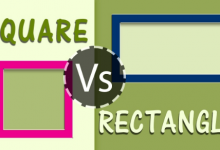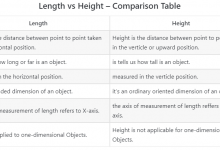Difference between Rhombus and Square
When it comes to geometric shapes, the rhombus and square are often mentioned in the same breath. Both are four-sided polygons, but they have distinct differences that set them apart. In this article, we will take a closer look at the key difference between rhombus and square and explore the unique characteristics of each shape.
Overview
First, let’s start with an overview of both shapes. A rhombus is a four-sided polygon with all sides of equal length. It is also known as a diamond shape due to its characteristic pointed corners. On the other hand, a square is a four-sided polygon with all four sides of equal length and all four angles measuring 90 degrees.
To better understand the differences between these two shapes, let’s take a look at a comparison table:
| rhombus | Square |
|---|---|
| All sides are of equal length | All four sides are of equal length |
| Opposite angles are congruent | All angles are 90 degrees |
| Opposite sides are parallel | Opposite sides are also parallel |
| Diagonals bisect each other at 90 degrees | Diagonals bisect each other at 90 degrees |
| The area can be calculated using d1*d2/2 | The area can be calculated using s^2 |
| It is a special case of a parallelogram | It is a special case of a rectangle |
As we can see from the table, both shapes have some similarities, such as all sides being of equal length and diagonals bisecting at 90 degrees. However, there are also some key differences. The most notable difference is that all angles in a square measure 90 degrees, while in a rhombus, opposite angles are congruent.
Additionally, the area of a square can be calculated using the side length squared (s^2), while the area of a rhombus is calculated using the product of the diagonals (d1*d2/2).
Now that we have a general understanding of the similarities and differences between these two shapes, let’s delve into the specifics of each shape.
What is a rhombus?
A rhombus is defined as a four-sided polygon with all sides of equal length. It is also known as a diamond shape due to its characteristic pointed corners. The diagonals of a rhombus bisect each other at 90 degrees and are also of equal length. The formula for calculating the area of a rhombus is d1*d2/2, where d1 and d2 are the lengths of the diagonals.
What is a Square?
On the other hand, a square is defined as a four-sided polygon with all four sides of equal length and all four angles measuring 90 degrees. The diagonals of a square also bisect each other at 90 degrees and are also of equal length. The formula for calculating the area of a square is s^2, where s is the length of one side.
Closing Remarks
In conclusion, while a rhombus and a square share some similarities, such as all sides being of equal length and diagonals bisecting at 90 degrees, there are also key differences between the two shapes. The most notable difference is that all angles in a square measure 90 degrees, while in a rhombus, opposite angles are congruent.
Additionally, the area of a square can be calculated using the side length squared (s^2), while the area of a rhombus is calculated using the product of the diagonals (d1*d2/2). Understanding the differences between these two shapes is important in various fields such as mathematics, engineering, and architecture.



